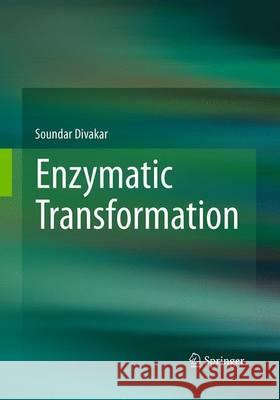Enzymatic Transformation » książka



Enzymatic Transformation
ISBN-13: 9788132228561 / Angielski / Miękka / 2016 / 284 str.
Enzymatic Transformation
ISBN-13: 9788132228561 / Angielski / Miękka / 2016 / 284 str.
(netto: 548,21 VAT: 5%)
Najniższa cena z 30 dni: 576,96 zł
ok. 20 dni roboczych
dostawa w 2025
Darmowa dostawa!
This book brings out the practical difficulties in carrying out enzyme catalyzed reactions in non-polar solvent. It outlines various strategies adopted to enhance especially yield and selectivity in such reactions.
Preface.- Abstract of Chapters.- Chapter 1 Introduction.- Chapter 2 Glycosidases.- 2.1 Amylolytic enzymes.- 2.2 Glucoamylase.- 2.3 Sources of glucoamylases.- 2.4 Sources of other glycosidases.- 2.5 Structural features of glucoamylase.- 2.6 Structural features of -glucosidase.- 2.7 Glycosylation .- 2.8 Mechanism of Glycosylation .- 2.9 Glycosylation reactions.- 2.10 Advantages of enzymatic glycosylation over chemical methods.- Chapter 3 Lipases.- 3.1 Lipases.- 3.2 Lipase specificity.- 3.3 Reactions catalyzed by lipases.- 3.4 Mechanism of lipase catalysed esterification in organic solvents.- 3.5 Esterification Reactions.- 3.6 Advantages of lipase catalysis over chemical catalysis .- Chapter 4 Enzymatic Esterification of Compounds Possessing Multifunctional Hydroxyl and Carboxyl Groups .- 4.0 Introduction.-4.1 2-O-Acyl Esters of Lactic Acid.- 4.2 Tolyl Esters.- 4.3 Application of Plackett-Burman Design for Lipase Catalyzed .- Esterification of Anthranilic Acid .- 4.4 Kinetic Study of Porcine Pancreas Lipase Inhibition by p-Cresol (p- Cresyl acetate) and Lactic acid (2-O-Stearoyl lactate) .- 4.5 Thermostability of Porcine Pancreas Lipase.- 4.6 Scanning Electron Microscopy .- 4.7 Hydrogen ions in Microaqueous Phase During Lipase Catalyzed Esterification in Non-Aqueous Media.- 4.8 Acetylation of Protocatechuic Aldehyde.- 4.9 4-t-Butylcyclohexyl Acetate.- 4.10 Esterification of β-Cyclodextrin.- Chapter 5 Enzymatic Polymerization.- 5.0 Introduction.- 5.1 Poly Lactic acid.- 5.2 Poly -Caprolactone .- 5.3 Poly-p -hydroxybenzoate .- 5.4 Poly-p -benzamide.- 5.5 Polyadipates.-Chapter 6 Lipase Catalyzed Preparation of Aminoacyl Esters of Carbohydrates.- 6.0 Introduction.-6.1 L-Alanyl-D-Glucose.- 6.2 Synthesis of L-valyl-D-glucose.- 6.3 L-Leucyl-D-Glucose.- 6.4 Syntheses of L-isoleucyl esters of carbohydrates .- 6.5 Synthes¬is of L-phenylalanyl-D-glucose.-6.6 L-Prolyl Esters of Carbohydrates.- 6.7 L-Tryptophanyl esters of carbohydrates.- 6.8 L-Histidyl esters of carbohydrates.-6.9 Spectral characterization of L-alanyl, L-valyl, L-leucyl and L-isoleucyl L-prolyl, L-phenylalanyl, L- tryptophanyl and L-histidyl esters of carbohydrates.- 6.10 Discussion.-Chapter 7 Enzymatic Glycosylation of Alcohols .-7.0 Introduction: .-7.1 n-Octyl-D-glucoside.- 7.2 Synthesis of n-octyl-D-glucoside using -glucosidase.-7.3 Determination of Critical Micellar Concentration (CMC) .- 7.4 Synthesis of n-octyl glycosides .- 7.5 Spectral characterization.- 7.6 Synthesis of n-alkyl glucosides using amyloglucosidase.-7.7 Cetyl and Stearyl glucosides.-7.8 Optimization of n-octyl-D-glucoside synthesis using Response Surface Methodology.-Chapter 8 Glycosylation of Some Selected Phenols and Vitamins.- 8.1.0 PHENOLS.-8.2.0 VITAMINS .-Chapter 9 Glycosylation of Phenols and Vitamins – An Overview .- 9.1 General.- 9.2 n-Alkyl Glycosides.-9.3 Curcuminyl-bis-glycosides.- 9.4 N-Vanillyl-Nonanamide Glycosides.- 9.5 Vanillyl Glycosides.- 9.6 DL-Dopa Glycosides.- 9.7 Dopamine Glycosides.-9.8. Riboflavinyl Glycosides .- 9.9. Retinyl Glycosides.- 9.10 Ergocalciferyl Glycosides.- 9.11 Cholecaciferyl Glycosides.-9.12 -Tocopheryl Glycosides.- Chapter 10 Kinetics of Some Selected Enzyme Catalyzed Reactions in Organic Solvents.- 10.1 Introduction.- 10.2 Methodology.- 10.3 Esterification Kinetics .- 10.4 Glycosylation Kinetics.- 10. 5 Discussion.-Chapter 11 ACE Inhibition and Antioxidant Activities of Enzymatically Synthesized Aminoacyl Esters And Glycosides.- 11.1 ACE Inhibition by Amino Acyl Esters of Carbohydrates.- 11.2. ACE Inhibition of Glycosides.-11.3 Antioxidant activity of Glycosides.
Dr Divakar is working as a Chief Scientist in the Central Food Technological Research Institute, Mysore, where he joined as a Scientist. Before this, he served as CSIR Pool Officer at Molecular Biophysics Unit, Indian Institute of Science, Bangalore, After completing his post-graduation in 1976 from Pachaiyappa’s College, Chennai, he had a brief stint in a polymer industry, M/S Reichhold Chemicals, Ind. Ltd., Chennai. He completed his PhD degree in Chemistry from the Australian National University, Canberra, Australia in 1982. The author is actively involved in research for the past 36 years. He developed few alkyd, phenol-formaldehyde, urea-formaldehyde and epoxy polymers, while working in the industry. While working as a Research and Development chemist at Ms. Reichhold Chemicals (Ind.) Ltd, he was actively involved in research in the fields of Alkyd resins, Unsaturated polyesters, Phenol-formaldehyde resins (resoles and novolaks), Urea-formaldehyde resins, and Epoxy resins After completing his PhD, he was involved in research work on three important areas, namely, i) NMR investigations of some biological systems ii) Host-guest complexation Chemistry with special reference to Cyclodextrins iii) Enzyme Catalyzed Transformation reaction employing lipases and glycosidases He has so far guided various PhD and MSc students. He has so far published about 149 research articles including reviews. His work on Enzymatic Transformations has resulted in about 70 publications, which prompted him to write this book on Enzymatic Transformation.
Transformations using enzymes have been extensively investigated in the last two decades and the results promise great potential for this growing field, especially in the area of synthetic organic chemistry mainly due to of its many advantages. Accordingly, this book has attempted to bring out the advantages of using enzymes involving complex underivatized and unprotected substrates in non-polar media under homogenous and heterogeneous reaction conditions. Merits and demerits of using enzymes in terms of yields and selectivity/specificity are presented without any prejudice.
Almost all the reactions dealt with are from the author’s laboratory comprising diverse substrates, and the catalysis involves two important hydrolyzing enzymes, extensively examined for the reverse reactions. Thus, esterification involving lipses and glycosylation involving glycosidases were investigated with respect to various strategies like optimization of reaction conditions, response surface methodology and kinetics, carrying out reactions under solvent, non-solvent and super critical carbon dioxide conditions.
In short, the work presented is to ensure the comprehension of the problems faced by the researchers in this area so as to work out further efficient strategies for carrying out enzymatic transformations in the laboratory successfully with better yields and specificity.
1997-2024 DolnySlask.com Agencja Internetowa
KrainaKsiazek.PL - Księgarnia Internetowa









